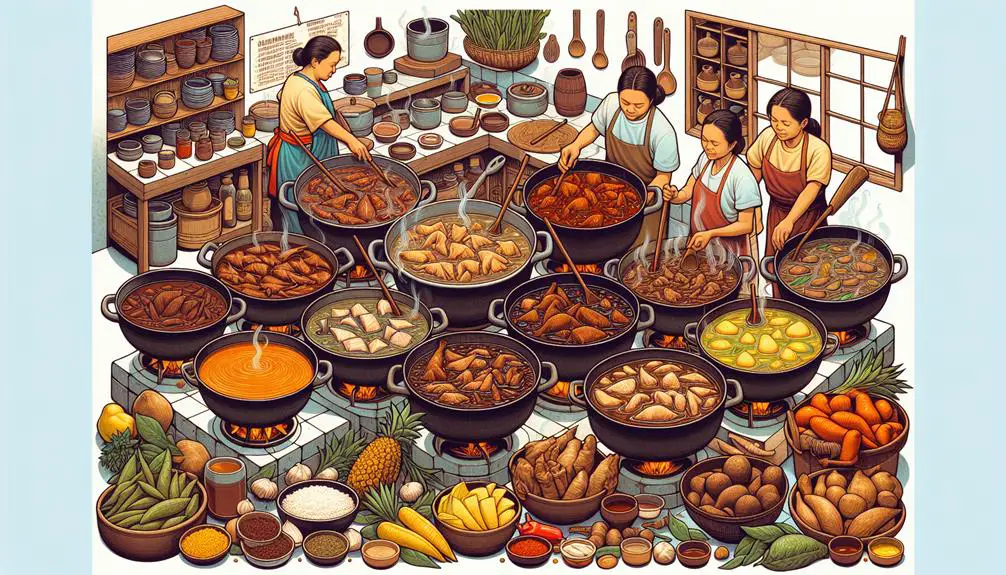Chicken Adobo is a yummy dish from the Philippines. It’s really popular and has been around for a long time. People in the Philippines made it even before the Spanish came over.
After the Spanish arrived, the dish changed a bit and got its name ‘Adobo.’ It’s famous because it tastes good and you can make it in different ways. Some people add potatoes or pineapple to their Chicken Adobo to make it their own special recipe.
It’s cool to see how one dish can change and still be loved by so many people!
Origin of Adobo

Adobo is a special food from the Philippines that has been around since before the Spanish came to the islands. A long time ago, Filipino people used vinegar and salt to keep their food from going bad. They didn’t have refrigerators back then, so they’d to find a way to make their food last longer, especially in the hot weather.
The word ‘adobo’ comes from a Spanish word ‘adobar’ which means ‘to marinate’. The first time someone wrote down the word ‘adobo’ was in a Spanish dictionary called Vocabulario de la lengua tagala in the year 1613.
Even before the Spanish arrived, using vinegar and salt was an important way to cook in the Philippines. It helped their meat stay good to eat for more days. When the Spanish got to the Philippines, they saw how the Filipinos did this and thought it was a great idea. They started to use this way of cooking, too.
As time passed, the recipe for adobo changed a little. People began to add soy sauce, garlic, and other yummy spices to make it even better. When we look at how adobo was made a long time ago, we can see that it’s a big part of what makes Filipino food so special. It shows us how smart and creative the people were to come up with such a tasty dish that could last a long time.
Today, adobo is still very popular and is considered one of the national dishes of the Philippines.
Spanish Influence

Before Spain came to the Philippines, people there already used vinegar and salt to keep their food good for a long time. This way of cooking helped create adobo, a special kind of food that got some Spanish touches later on. Adobo isn’t just a Filipino word; it got its name from the Spanish.
When the Spanish people made the Philippines their home in the 1500s and 1600s, they saw how the locals liked to soak and cook their food in yummy sauces. In Spain, ‘adobo’ meant soaking meat in vinegar and spices to make it last longer. The Spanish started calling any soaked Filipino food ‘adobo,’ mixing the Filipino way of cooking with their own traditions.
The way ‘adobo’ got its name shows how the people from the Philippines and Spain shared their ways of cooking during the time when Spain was in charge. Using the word ‘adobo’ was a way to show that the Spanish liked the Filipino style and even added it to their own recipes. This mix of cooking ways made a special type of food that people in the Philippines are still proud of today.
The story of adobo is cool because it shows how the food there’s been influenced by both their own ideas and those from other places, making a yummy blend of tastes and ways to cook.
Evolution and Cultural Significance

Adobo is a special dish from the Philippines that has changed over many years. It uses ingredients and ways of cooking that are special to the Philippines. Adobo is very important in Filipino culture. It shows the history and what makes the country special. People in the Philippines have made many different kinds of adobo with different meats and spices.
For example, there’s a kind called ‘adobo sa gata’ which has coconut milk. It comes from the Bicol area. Another kind is ‘adobong dilaw,’ which uses turmeric and comes from the Visayas area. People also mix adobo with other foods to make new dishes. This has made adobo popular in the Philippines and in other countries too.
Adobo is often called the national dish of the Philippines. This means it’s a very important food that shows the country’s long history and many different flavors.
Recipe Variations

Let’s talk about how to make Chicken Adobo and the different ways you can change it up!
Chicken Adobo is a yummy dish where you marinate chicken in vinegar, soy sauce, garlic, and peppercorns, and then cook it until it’s tender. People love this dish because it’s tangy and full of flavor.
But did you know there are different ways to make Chicken Adobo depending on where you are?
For example, some cooks in the Philippines add coconut milk, which makes the dish creamy and a little sweet. This version is called Adobo sa Gata. Another twist is adding turmeric. This gives the chicken a bright yellow color and a nice, earthy taste.
These changes to the recipe are super cool because they show how Chicken Adobo can be different and special in each place. If you like the classic sour and savory taste, that’s great! But if you want to try something new, there are lots of options to explore.
Here’s a simple way to remember how to make Chicken Adobo: Marinate the chicken, cook it well, and then decide if you want to add something extra like coconut milk or turmeric. This will make your Chicken Adobo delicious and unique, just like the places it comes from!
Regional Variations

Exploring the diverse styles of chicken adobo across different Philippine regions reveals the rich influences of local ingredients and cooking traditions, shaping the unique and vibrant Filipino identity.
Each region’s variation of chicken adobo reflects the abundance of local ingredients and the distinct cooking techniques passed down through generations.
In the Bicol region, adobo sa gata incorporates creamy coconut milk, offering a subtly sweet and rich flavor.
On the other hand, adobong puti from the Ilocos region uses salt rather than soy sauce, resulting in a clearer, lighter-colored dish.
Adobo sa dilaw from the Visayas region features turmeric, adding a vibrant yellow hue and a subtle earthy flavor.
In Batangas, adobo sa asin highlights the simplicity of salt-based seasoning.
Meanwhile, Mindanao’s adobo with pineapple introduces a delightful tropical twist.
These regional variations not only showcase the diversity of Philippine cuisine but also contribute to the rich tapestry of Filipino culinary heritage.
Adobo in Modern Filipino Cuisine

Chicken adobo is a famous dish in the Philippines that mixes old and new ways of cooking. It is important in Filipino homes and showcases how chicken adobo can change while still being delicious. Adobo is made with vinegar, soy sauce, garlic, and bay leaves.
Nowadays, people cook it in new ways, and it has gained popularity around the world. For Filipino people living in other countries, adobo is a special food that reminds them of home and helps them stay connected to their roots.
Cultural Significance

Adobo is super important when Filipinos are being friendly and having a good time with family and friends. It’s like a special dish that shows how much they care about their cooking and being together.
When they make adobo, everyone sometimes helps out, like mixing the sauce and cooking the meat. It’s not just food; it’s a way for everyone to feel like they’re part of a big family.
In the Philippines, making adobo is a way to show love. Each family might have a secret way to make it that they’ve known for a really long time. At parties, the yummy smell of adobo cooking makes everyone feel happy and think of good times. If it’s someone’s birthday, a wedding, or a big holiday, you can bet adobo will be there, making everyone feel happy and close to each other.
Adobo is also a way to say ‘welcome’ to guests and show how Filipino people are super kind and like to share. Adobo can be made in different ways, so no matter what you like to eat, you’ll probably enjoy it. That’s why adobo is more than just a tasty dish; it’s a way for Filipinos to show friendship and have fun together.
Common Misconceptions

Did you know that some people get things mixed up about adobo, that yummy Filipino food? Let me tell you about these mix-ups and set things straight.
First off, some folks think adobo started when the Spanish were in the Philippines. But guess what? Filipinos were making adobo way before that, using their own way of cooking.
Also, some think that you have to use soy sauce to make real adobo. Nope! Depending on where you’re in the Philippines, people might put stuff like yellow spice called turmeric, plain old salt, or creamy coconut milk in their adobo instead. It’s super cool how every place has its own special version of adobo.
Another thing people get wrong is that they think adobo is only made with chicken or pork, but that’s not true. You can use all kinds of meat, fish, or even veggies to make different kinds of adobo.
Recipe Evolution and Trends

Did you know adobo chicken isn’t just made the old way anymore? Now, people are coming up with cool new ideas to make this favorite Filipino dish even better! People are trying to make adobo healthier, like switching out soy sauce for something called tamari, which doesn’t have gluten, or using something called coconut aminos to cut down on salt.
There are also adobo recipes that mix in flavors from other parts of the world, making it like a food mash-up that tastes really awesome.
Some cooks are getting really creative, especially for people who don’t eat meat. They’re using things like mushrooms or tofu to make a veggie version of adobo. Plus, they’re adding all sorts of different spices and herbs to make it taste new and exciting. And guess what? Now, there are even high-tech ways to cook adobo, like using fancy machines that help make the chicken super tender and tasty.
All these changes are making adobo chicken more and more popular, not just in the Philippines, but everywhere! It’s cool to see how people are keeping the tradition alive while also trying out new things. It just goes to show that even classic dishes like adobo can get a fun makeover and still be a hit!
Wrapping Up
So next time you savor the rich flavors of Chicken Adobo, remember its deep-rooted history and cultural significance in Filipino cuisine.
From its indigenous origins to the Spanish influence and modern adaptations, adobo has stood the test of time as a symbol of Filipino identity and hospitality.
Whether you enjoy the classic recipe or explore regional variations, Chicken Adobo continues to be a beloved dish celebrated both locally and internationally.
Embrace the tradition and savor the taste of history in every bite.
